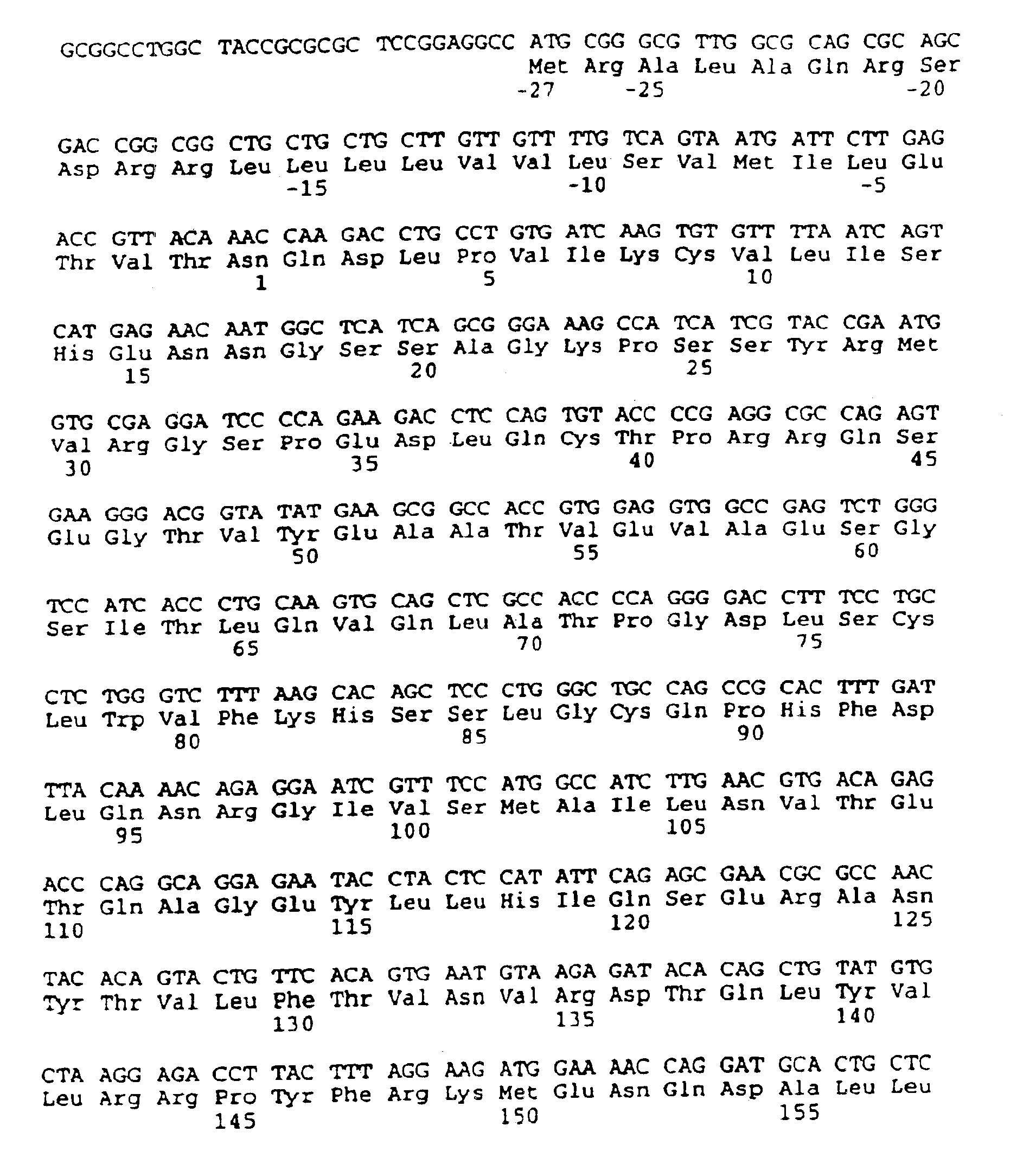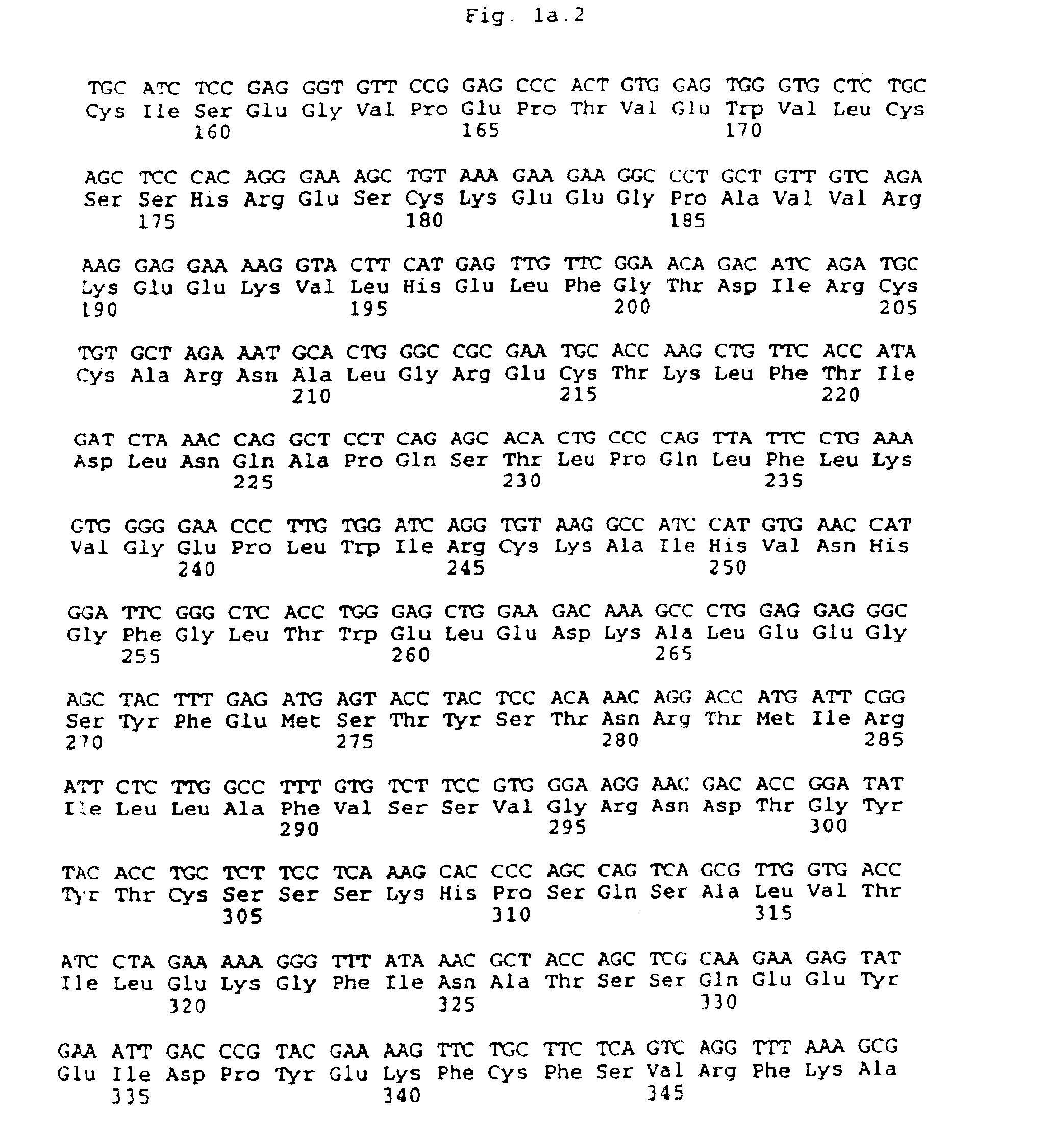Method for isolating cells expressing flk-2
a technology of hematopoietic stem cells and isolating cells, which is applied in the field of hematopoietic stem cell receptors, can solve the problems of complex role of growth factors, inability to fully understand the effect of growth factors, and experiments that do not necessarily reflect in vivo realities
- Summary
- Abstract
- Description
- Claims
- Application Information
AI Technical Summary
Benefits of technology
Problems solved by technology
Method used
Image
Examples
example 1
Cells Containing Mouse flk-1 and flk-2 Ligands Murine Stromal Cell Line 2018.
[0096]In order to establish stromal cell lines, fetal liver cells are disaggregated with collagen and grown in a mixture of Dulbecco's Modified Eagle's Medium (DMEM) and 10% heat-inactivated fetal calf serum at 37° C. The cells are immortalized by standard methods. A suitable method involves introducing DNA encoding a growth regulating- or oncogene-encoding sequence into the target host cell. The DNA may be introduced by means of transduction in a recombinant viral particle or transfection in a plasmid. See, for example, Hammerschmidt et al., Nature 340, 393-397 (1989) and Abcouwer et al, Biotechnology 7, 939-946 (1989). Retroviruses are the preferred viral vectors, although SV40 and Epstein-Barr virus can also serve as donors of the growth-enhancing sequences. A suitable retrovirus is the ecotropic retrovirus containing a temperature sensitive SV40 T-antigen (tsA58) and a G418 resistance gene described by ...
example 2
Cells Containing Human flk-1 and flk-2 Ligands
[0098]Human fetal liver (18, 20, and 33 weeks after abortion), spleen (18 weeks after abortion), or thymus (20 weeks after abortion) is removed at the time of abortion and stored on ice in a balanced salt solution. After mincing into 1 mm fragments and forcing through a wire mesh, the tissue is washed one time in Hanks Balanced Salt Solution (HBSS).
[0099]The disrupted tissue is centrifuged at 200×g for 15 minutes at room temperature. The resulting pellet is resuspended in 10-20 ml of a tissue culture grade trypsin-EDTA solution (Flow Laboratories). The resuspended tissue is transferred to a sterile flask and stirred with a stirring bar at room temperature for 10 minutes. One ml of heat-inactivated fetal bovine calf serum (Hyclone) is added to a final concentration of 10% in order to inhibit trypsin activity. Collagenase type IV (Sigma) is added from a stock solution (10 mg / ml in HBSS) to a final concentration of 100 ug / ml in order to dis...
example 3
Isolating Stromal Cells
[0100]Resuspended Cells (example 2) that are incubated at 37° C. with 5% carbon dioxide begin to adhere to the plastic plate within 10-48 hours. Confluent monolayers may be observed within 7-10 days, depending upon the number of cells plated in the initial innoculum. Non-adherent and highly refractile cells adhering to the stromal cell layer as colonies are separately removed by pipetting and frozen. Non-adherent cells are likely sources of populations of self-renewing stem cells containing flk-2. The adherent stromal cell layers are frozen in aliquots for future studies or expanded for growth in culture.
[0101]An unexpectedly high level of APtag-flk-2 fusion protein binding to the fetal spleen cells is observed. Two fetal spleen lines are grown in “stromal medium,” which is described in example 2.
[0102]Non-adherent fetal stem cells attach to the stromal cells and form colonies (colony forming unit—CFU). Stromal cells and CFU are isolated by means of sterile gl...
PUM
| Property | Measurement | Unit |
|---|---|---|
| temperature | aaaaa | aaaaa |
| temperature | aaaaa | aaaaa |
| concentration | aaaaa | aaaaa |
Abstract
Description
Claims
Application Information
 Login to View More
Login to View More - R&D
- Intellectual Property
- Life Sciences
- Materials
- Tech Scout
- Unparalleled Data Quality
- Higher Quality Content
- 60% Fewer Hallucinations
Browse by: Latest US Patents, China's latest patents, Technical Efficacy Thesaurus, Application Domain, Technology Topic, Popular Technical Reports.
© 2025 PatSnap. All rights reserved.Legal|Privacy policy|Modern Slavery Act Transparency Statement|Sitemap|About US| Contact US: help@patsnap.com



